PACKAGE: The Everything Package (200 Hours)
| Average Ratings | |
|---|---|
| Five Stars | Not Rated |

![]()
![]()
![]()
![]()
![]()
“Your courses fit my needs perfectly.
They were ideal for someone who does not
have a great deal of flexibility, and I learned a lot.”
You’ve heard of the everything bagel, Professional Learning Board presents the everything PD course package, The Everything Self-Study Package, which includes the following FORTY self-study courses adding up to 200 hours of professional development. Scroll down to see more information on the courses in this package.
|
The Everything Package (200 hours)
|
# Hours
|
|---|---|
|
Accommodating All Learners
|
5
|
|
Accommodations through UDL
|
5
|
|
Apps for Education
|
5
|
|
Bulletin Boards – Ideas for Every Classroom
|
5
|
|
Bullying Prevention & Policies for Schools
|
5
|
|
Child Abuse Prevention
|
5
|
|
Classroom Collaboration
|
5
|
|
Classroom Management for Positive Behaviors
|
5
|
|
Classroom Organization for the 21st Century
|
5
|
|
Cognitive Skills – Understanding Learning Challenges
|
5
|
|
Curriculum Development
|
5
|
|
Differentiation for Gifted Learners in the Classroom
|
5
|
|
English Language Learners in the Classroom
|
5
|
|
Ethics for Education Professionals
|
5
|
|
Examining and Evaluating Student Work
|
5
|
|
Formative Assessment
|
5
|
|
IEPs: Documentation and Implementation for Teachers
|
5
|
|
Inquiry-based Learning
|
5
|
|
Integrating Standards in Teaching
|
5
|
|
Internet Safety: Protecting Children in an Online World
|
5
|
|
Introduction to Autism
|
5
|
|
Introduction to Technology for Teachers
|
5
|
|
iPads in the Classroom
|
5
|
|
Language Acquisition
|
5
|
|
Partnering with Parents
|
5
|
|
Project Management for Students through Project-based Learning
|
5
|
|
Public Speaking for Teachers
|
5
|
|
Reading Across the Curriculum
|
5
|
|
Reading through Technology in the Classroom
|
5
|
|
Recognizing Early-onset Mental Health Disorders in Children and Adolescents
|
5
|
|
Reflective Teaching Practices
|
5
|
|
Research Based Instructional Strategies
|
5
|
|
Standards Based Instruction through STEM
|
5
|
|
Student Portfolios
|
5
|
|
Suicide Prevention
|
5
|
|
Tackling Tough Text
|
5
|
|
Technology in the 21st Century Classroom
|
5
|
|
Transformative Classroom Management
|
5
|
|
Understanding ADHD
|
5
|
|
Virtual Field Trips
|
5
|
|
TOTAL
|
200
|
Accommodating All Learners
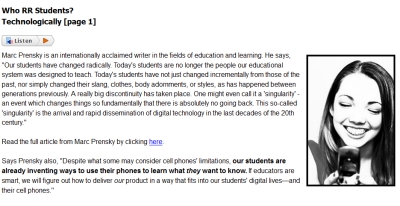 Reach and teach all learners by examining 21st century student and educator strengths in this research-based course packed with strategies, resources and tools. Participants will gain insight into both, their own learning and teaching preferences as well as the learning styles of students. Closely aligned with national standards and pedagogical goals.
Reach and teach all learners by examining 21st century student and educator strengths in this research-based course packed with strategies, resources and tools. Participants will gain insight into both, their own learning and teaching preferences as well as the learning styles of students. Closely aligned with national standards and pedagogical goals.
- Every Learner Learning
- Who’s Who: Teaching & Learning
- Who RR Students?
- Teaching Across Type
- Technology
- Theories & Strategies
Accommodations through UDL
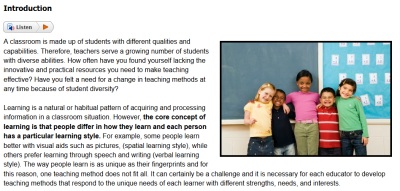 Teaching each and every student effectively is never easy. It is next to impossible to find a classroom full of students with the same needs, learning levels and abilities. Teachers are faced with the challenge of teaching a diverse group the same lesson and ensuring that they all learn in the process. It can be easy to settle for teaching some, or even most of the students, while leaving out a portion of the class in the process.
Teaching each and every student effectively is never easy. It is next to impossible to find a classroom full of students with the same needs, learning levels and abilities. Teachers are faced with the challenge of teaching a diverse group the same lesson and ensuring that they all learn in the process. It can be easy to settle for teaching some, or even most of the students, while leaving out a portion of the class in the process.
This course is designed to present teachers with the Universal Design of Learning (UDL) framework, which makes teaching ALL students a very real possibility. The framework builds on research findings that show how a single teaching approach has very limited results on student learning, highlighting the need for a new curricular approach. Here a learner’s level of recognition, strategic, and affective networks are all taken into account to determine the best way to teach them.
The course is centered around exploring practical strategies that can be used to add a much needed element of flexibility in teaching presentation, student expression and meaningful engagement and upholding learning as the primary focus.
Apps for Education
 Integrate Ruben Puentedura’s SAMR model with Alan November’s work on Transformative Learning to find the best apps to educate YOUR students. The integration of apps into education, may seem like a natural product of the times. However, successfully impacting students’ learning, requires a whole new level of teachers’ engagement and effort.
Integrate Ruben Puentedura’s SAMR model with Alan November’s work on Transformative Learning to find the best apps to educate YOUR students. The integration of apps into education, may seem like a natural product of the times. However, successfully impacting students’ learning, requires a whole new level of teachers’ engagement and effort.
Teachers will be equipped to go beyond using an app merely because someone else has recommended it and fully examine the true learning potential.
To this end, teachers must take into account specifics, including logistics, ability to manage, content access, sound and image quality, all while evaluating individual apps. A comprehensive App Evaluation Framework, specially designed for the classroom context is presented for teachers’ critical consideration of educational apps before deciding to introduce them to students. With an integrated approach, teachers can successfully consider an apps’ connections with curriculum content and ability to amplify existing learning levels, while evaluating systematically their transformative learning capability.
Bulletin Boards – Ideas for Every Classroom
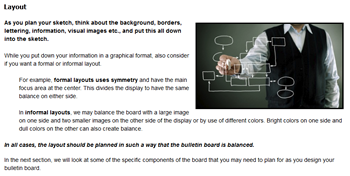 A classroom can seem incomplete without attractive and educative bulletin boards. Have you ever looked at another teacher’s bulletin boards and wondered how they managed to make it so interesting? Maybe you don’t have a lot of experience with art, or maybe you’re running low on creative ideas.
A classroom can seem incomplete without attractive and educative bulletin boards. Have you ever looked at another teacher’s bulletin boards and wondered how they managed to make it so interesting? Maybe you don’t have a lot of experience with art, or maybe you’re running low on creative ideas.
This course provides a new and fresh direction that helps teachers understand the basic principles of art and design and how to apply these in planning and creating bulletin boards. Included are a number of ideas for interesting, interactive and educative bulletin boards. Through this course, teachers come up with some very creative and visually effective ideas for their classrooms and often are inspired to create their own classroom bulletin board makeovers.
Bullying Prevention & Policies for Schools
Bullying is a form of behavior and can be either covert or overt in nature. Bullying incidents vary in their severity and impact. Most mild bullying behavior can be managed by the students themselves. More severe incidents may require intervention from teachers and other school staff. Therefore, schools have a valuable role in supporting students to develop effective ways to relate to others.
The aim of this online course is to enable teachers to build a school culture where bullying has no place, by modeling and fostering healthy social interactions among students. This course helps teachers to develop their understanding of bullying and gives them confidence to respond to and address it. The practical strategies in this course can be adapted by teachers to meet the specific needs of their individual classrooms. Teachers are empowered to prevent and respond to bullying effectively as part of promoting positive environments in which all students can learn and thrive.
Child Abuse Prevention
 Child Abuse and Neglect is a very serious issue that is harming and threatening the safety and well being of our children. Besides the immediate negative impact, the greatest harm of Child Maltreatment is that it can lead to a vicious intergenerational cycle of abuse, in which the abused becomes the abuser. As teachers, our responsibility is not limited to academic performance, but to the overall development and welfare of our students. It is vital that we fight against Child Abuse and Neglect. This course, Recognizing Child Abuse, will equip you with the necessary information and skills to do so.
Child Abuse and Neglect is a very serious issue that is harming and threatening the safety and well being of our children. Besides the immediate negative impact, the greatest harm of Child Maltreatment is that it can lead to a vicious intergenerational cycle of abuse, in which the abused becomes the abuser. As teachers, our responsibility is not limited to academic performance, but to the overall development and welfare of our students. It is vital that we fight against Child Abuse and Neglect. This course, Recognizing Child Abuse, will equip you with the necessary information and skills to do so.
Teachers will be introduced to the basics and fundamental facts of Child Abuse and Neglect, its types, indicators and risk factors. The course primarily aims at educating teachers on the abuse, its legal implications and the legislative statutes addressing them in their role as Mandatory Reporters. Understanding this information is crucial to the early identification and recognition of victims of Child Maltreatment. This course will also educate teachers about the procedures for reporting Child Abuse and Neglect. Using the templates and ideas included in the course, teachers can effectively fight against Child Abuse and Neglect and help ensure the safety of students.
Classroom Collaboration
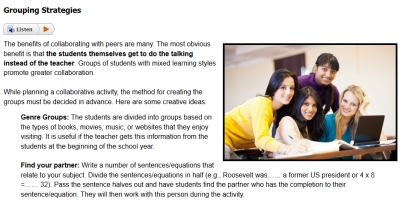 Implement collaborative learning in classrooms and develop successful learners. This framework enables teachers to recognize characteristics of collaborative classrooms, be aware of student and teacher roles, and practice group activities as an essential part of the classroom. Teachers are introduced to school-wide policy reforms in place today that promote collaboration and group activities. Teachers are also provided with ideas and strategies to accommodate learners, including students with special needs. The practical examples, real-life experiences, and templates in this online course provide teachers a structure to use in their own classrooms.
Implement collaborative learning in classrooms and develop successful learners. This framework enables teachers to recognize characteristics of collaborative classrooms, be aware of student and teacher roles, and practice group activities as an essential part of the classroom. Teachers are introduced to school-wide policy reforms in place today that promote collaboration and group activities. Teachers are also provided with ideas and strategies to accommodate learners, including students with special needs. The practical examples, real-life experiences, and templates in this online course provide teachers a structure to use in their own classrooms.
Classroom Management for Positive Behaviors
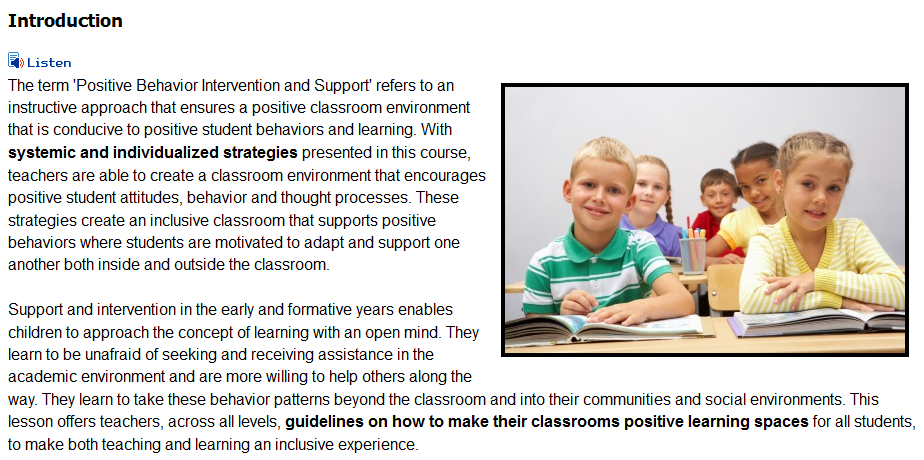 Successfully implement an evidence-based, data-driven Positive Behavior Management system in your school in order to reduce disciplinary incidents and support positive academic outcomes. Through the resources, research-validated strategies and guidelines, presented in this course, teachers will be equipped to apply a multi-tiered approach to prevention. Using disciplinary and behavior analysis data, teachers will be able to develop targeted and individualized interventions and supports for problem students.
Successfully implement an evidence-based, data-driven Positive Behavior Management system in your school in order to reduce disciplinary incidents and support positive academic outcomes. Through the resources, research-validated strategies and guidelines, presented in this course, teachers will be equipped to apply a multi-tiered approach to prevention. Using disciplinary and behavior analysis data, teachers will be able to develop targeted and individualized interventions and supports for problem students.
Additionally, teachers will be provided with tips and strategies for teaching behavioral expectations, modeling them, and reinforcing positive social behavior for improving the student’s educational experience.
Questions answered in this course include – Why choose Positive Behavior Intervention Strategies (PBIS) for students? Shouldn’t students know how to behave? Why should students be acknowledged for doing what is expected?
Rich in examples, scenarios, suggestions and tips, this course will allow schools to implement the PBIS framework as a team-based, action planning process led by the school PBIS team, providing students with a positive learning environment.
Classroom Organization for the 21st Century
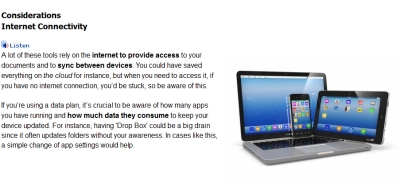 Good teaching is both an art and a science. It requires a significant amount of planning, research, preparation, evaluation, and a whole lot of creativity. However, that doesn’t mean teachers need to sacrifice their personal and family life for education. The key to “doing it all” and “doing it all well” is organization. A rested, relaxed, and organized teacher is an effective teacher.
Good teaching is both an art and a science. It requires a significant amount of planning, research, preparation, evaluation, and a whole lot of creativity. However, that doesn’t mean teachers need to sacrifice their personal and family life for education. The key to “doing it all” and “doing it all well” is organization. A rested, relaxed, and organized teacher is an effective teacher.
The aim of this course, The Organized Teacher, is to aid teachers as they strive to make their lives and classrooms more organized and a lot less stressful. There are tips, tools, templates, and creative ideas to help teachers organize the classroom environment, classroom activities, assessments, and other class events. The ideas in this course will present effective ways for teachers to be organized and to take practical steps to manage stressful days and avoid time crunches. This will have a positive impact on both themselves and their students.
Cognitive Skills – Understanding Learning Challenges
The U.S. Department of Education, and others indicate that weak cognitive skills are the source of over 80% of learning problems.
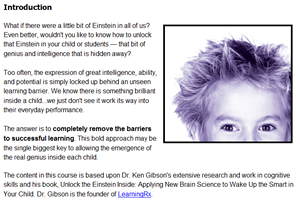 In this course you’ll come to understand the answer: students approach each task with varying learning tools. These tools are called cognitive skills, and these skills determine the quality, speed, and ease with which individuals learn and perform.
In this course you’ll come to understand the answer: students approach each task with varying learning tools. These tools are called cognitive skills, and these skills determine the quality, speed, and ease with which individuals learn and perform.
This course provides methods for detecting students with weak cognitive skills and tools to strengthen those skills. Teachers will receive understanding, as well as ways to apply development techniques in the classroom. The online class is fun and interactive and includes information about new brain research and how it can impact today’s classrooms.
Curriculum Development
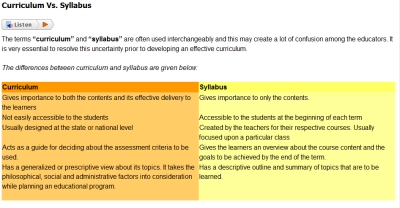 Traditional curriculum cannot always keep up with the challenges of the educational needs in today’s dynamic world. Hence, it is essential to redesign the curriculum. This course highlights the fact that each and every educator has the responsibility to contribute, even in small ways, to making a difference in the curriculum. The resources, examples and templates included, guide the teachers to plan, develop, integrate and evaluate curriculum more effectively. This information will empower teachers to implement novel ideas in curriculum development within their classrooms that will help students to face the challenges of the dynamic world around them with greater confidence. An effective curriculum will enable the students to become successful learners.
Traditional curriculum cannot always keep up with the challenges of the educational needs in today’s dynamic world. Hence, it is essential to redesign the curriculum. This course highlights the fact that each and every educator has the responsibility to contribute, even in small ways, to making a difference in the curriculum. The resources, examples and templates included, guide the teachers to plan, develop, integrate and evaluate curriculum more effectively. This information will empower teachers to implement novel ideas in curriculum development within their classrooms that will help students to face the challenges of the dynamic world around them with greater confidence. An effective curriculum will enable the students to become successful learners.
Differentiation for Gifted Learners in the Classroom
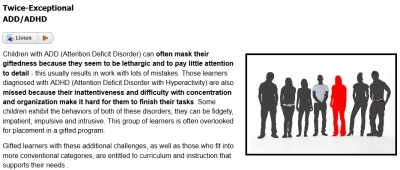 This course examines some of the challenges facing gifted learners and offers easily implemented accommodations and success strategies. By understanding the unique learning needs of children who are considered “gifted,” participants will indirectly meet the individual needs of all learners.
This course examines some of the challenges facing gifted learners and offers easily implemented accommodations and success strategies. By understanding the unique learning needs of children who are considered “gifted,” participants will indirectly meet the individual needs of all learners.
Through this course educators and parents can make greater sense of gifted and talented education by learning about identification, instruction and assessment of these students while exploring related topics, issues and resources geared towards our gifted population.
- Characteristics
- Personal, Social and Cognitive Needs
- Special Populations
- Practical Strategies
English Language Learners in the Classroom
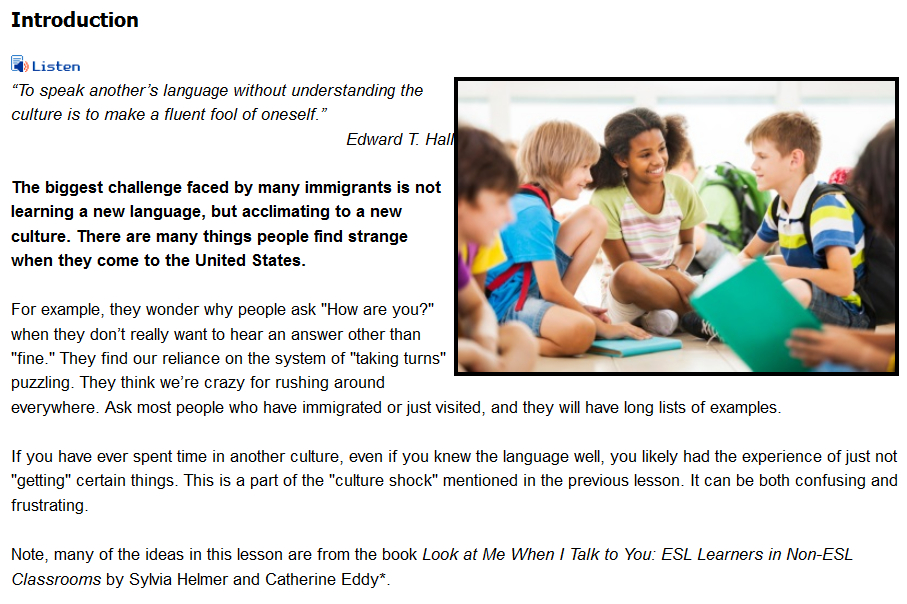 Facilitate optimal learning in the classroom by helping English Language Learners feel validated. This online PD course includes various strategies and methods that teachers can adopt to help English learners effectively adapt to an English school and curriculum. Teachers are provided with a range of strategies and activities that lead to interactions which benefit the four language skill areas of listening, speaking, reading and writing.
Facilitate optimal learning in the classroom by helping English Language Learners feel validated. This online PD course includes various strategies and methods that teachers can adopt to help English learners effectively adapt to an English school and curriculum. Teachers are provided with a range of strategies and activities that lead to interactions which benefit the four language skill areas of listening, speaking, reading and writing.
An overview of the Sheltered Instruction (SI) model is presented along with ways to apply this model when teaching English Language Learners. The importance of working collaboratively and ensuring the involvement of parents to enhance learning is emphasized with corresponding strategies. Through a range of research based findings, teachers are equipped to engage students in “higher order thinking skills” and design a sufficiently challenging curriculum.
Ethics for Education Professionals
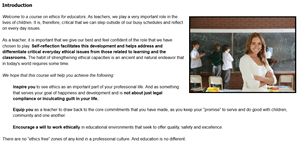 With the advent of the internet and smart phones, it’s easy for boundaries to become blurred. In the past it was rare for a student to call a teacher at home. Today, students and teachers are faced with numerous ways to contact one another 24/7. Things that in the past may have been black and white are now grey. Where do we draw the lines?
With the advent of the internet and smart phones, it’s easy for boundaries to become blurred. In the past it was rare for a student to call a teacher at home. Today, students and teachers are faced with numerous ways to contact one another 24/7. Things that in the past may have been black and white are now grey. Where do we draw the lines?
Even though most people believe that their actions are guided by logic and reason, we all have an innate ethical sense that urges us to make predictable choices. We each find words to create rationales that support our choices or decisions. However, ethics education is about recognizing the real power of our own innate ethical sense and how it influences our behaviors.
We build our ethical sense on beliefs that we already bring with us. This is why ethics is about individual’s personal choices. When we recognize and intuitively understand that ethics must be measured on a case-by-case basis, this type of ethical relationship can become a powerfully positive starting point for both educators and students. We must commit to broadening our understanding of ethical issues while at the same time seek to better understand the ideas of others.
Step inside this course and discover through reflection and introspection, an understanding of one’s innate ethical self. You’ll find tools and tips for bringing high standards of ethics into our schools and a variety of topics to explore practical ways to address ethical decisions in our lives at every stage.
Examining and Evaluating Student Work
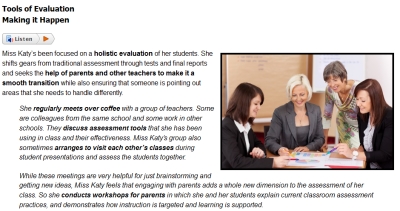 21st century students must have more than just textbook knowledge. Evaluating student learning goes beyond merely grading papers. Both schools and teachers need to intentionally move toward assessing students’ understanding, and then use this insight to enhance teaching and learning practices.
21st century students must have more than just textbook knowledge. Evaluating student learning goes beyond merely grading papers. Both schools and teachers need to intentionally move toward assessing students’ understanding, and then use this insight to enhance teaching and learning practices.
The wealth of resources and classroom examples provided here enable teachers to enhance existing evaluation practices. Calling for a shift in approach, the course lays out effective and dynamic methods by which teachers can assess student work. These help ensure that educational focus remains entirely on both teacher and student development. The course recommends expanding these best practices by “Examining Student Work” through a process of intentional reflection with other teachers. Through encouragement to engage with other teachers and learn from shared insights, teachers are equipped with useful resources to successfully implement this process.
Formative Assessment
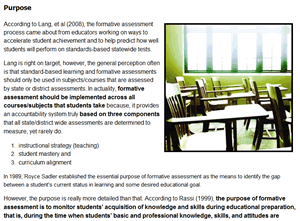 Is your school moving in the right direction?
Is your school moving in the right direction?
Can you tell if students are learning – how can you tell?
Brian Creasman became principal of a “low performing” high school and was confronted with these two questions. A high school classified as “low performing” obviously is not a title any teacher, administrator, student or parent wants for their school.
Out of everything (curriculum alignment, effective instructional strategies, etc.) Mr. Creasman learned that for an assessment to be effective, it should also be formative. Keep in mind that effective formative assessments result in instruction that meets the needs of each student. Formative assessments allow teachers to respond to the needs of the student quickly, however more importantly it allows the student to shape instruction (both a student-centered and teacher-driven education model).
The formative assessment program there continues and is constantly changing for the better. Once you have a well planned formative assessment program in place, your school will also see:
1) A change in the culture within classrooms
2) Concise communication of learning goals
3) Varied effective instructional methods
4) A new understanding for student learning
5) Improved student engagement with targeted student feedback
6) An increase in student learning!
Take the next step. Learn about and implement formative assessments in your school to discover and demonstrate for yourself, your students and your community what happens when a school moves in this direction and you know students are truly learning.
IEPs: Documentation and Implementation for Teachers
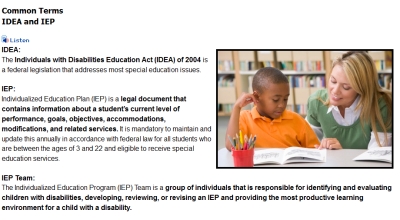 The goal of this course is to help teachers understand the IEP process and build the teachers comfort level in developing, aligning with and carrying out the IEP through rich examples and templates to help teachers understand and practically use the recommended strategies in a classroom setting.
The goal of this course is to help teachers understand the IEP process and build the teachers comfort level in developing, aligning with and carrying out the IEP through rich examples and templates to help teachers understand and practically use the recommended strategies in a classroom setting.
This course helps teachers provide children who have an Individualized Education Program (IEP) with an appropriate education in the least restrictive environment. It is designed to educate the educators on the various regulations and requirements while helping to develop a team that works together to improve educational results for children with special needs. Teachers will examine various supports and services a student with special needs may receive for instruction and testing.
Inquiry-based Learning
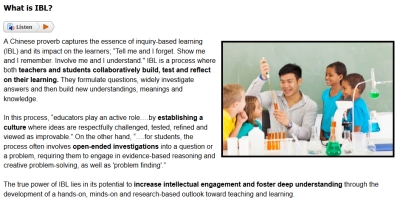 Preparing teachers for 21st century students requires a close look at what it means to teach and learn in increasingly networked, technology-rich, digital classrooms. Schools and teachers need to thoughtfully and intentionally design learning environments and tasks in which teachers explore issues that are relevant while developing pedagogies that are effective for a knowledge era. Utilizing new images and acquiring new expertise facilitates meaningful learning with technology. The Inquiry-based Learning (IBL) approach provides a platform for holistic education.
Preparing teachers for 21st century students requires a close look at what it means to teach and learn in increasingly networked, technology-rich, digital classrooms. Schools and teachers need to thoughtfully and intentionally design learning environments and tasks in which teachers explore issues that are relevant while developing pedagogies that are effective for a knowledge era. Utilizing new images and acquiring new expertise facilitates meaningful learning with technology. The Inquiry-based Learning (IBL) approach provides a platform for holistic education.
This course offers a framework for teachers to plan lessons that promote Inquiry-based Learning (IBL). Starting with explaining a need for such a shift in education, the course shows how an IBL classroom works. Through multiple classroom examples, teachers are able to understand what specific and new roles they play and how to encourage student initiative, while ensuring that the focus remains on productive matters.
The Inquiry-based Learning course details some models that teachers can adapt to meet specific needs of their class, as well as to monitor and enhance the learning of their students. Teachers learn practical and dynamic ways of evaluating their students’ progress while also incorporating technology for better results.
Integrating Standards in Teaching
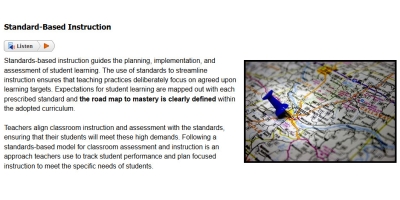 We’re told that a standards-based curriculum is supposed to increase student learning and promote higher student achievement, but what is it really all about? This course helps educators untangle what turns out to be the not-so-mysterious-language of today’s teaching and learning, and put successful strategies into practice.
We’re told that a standards-based curriculum is supposed to increase student learning and promote higher student achievement, but what is it really all about? This course helps educators untangle what turns out to be the not-so-mysterious-language of today’s teaching and learning, and put successful strategies into practice.
Internet Safety: Protecting Children in an Online World
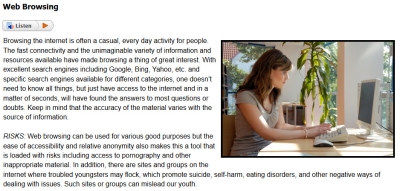 Issues that the youth of today, parents, teachers and those who are part of their world face online is the essence of this content. Participants discover areas of the Internet used by youth, what kinds of threats exist on the Internet and how everyone can protect their loved ones, family members, students and those under their care or responsibility. A special focus of the course includes ways in which adults can protect themselves online.
Issues that the youth of today, parents, teachers and those who are part of their world face online is the essence of this content. Participants discover areas of the Internet used by youth, what kinds of threats exist on the Internet and how everyone can protect their loved ones, family members, students and those under their care or responsibility. A special focus of the course includes ways in which adults can protect themselves online.
- Social networks
- Instant messaging & texting
- Chat rooms
- Gaming & virtual worlds
- Vulnerabilities of Children Online
- Cyberbullying
- Online predators
- Tips & tools for protecting children online
- And more…
Introduction to Autism
Most people today know someone with autism. People on the autism spectrum are in our classes, our neighborhoods and our families. Whether you know a little or a lot about autism, this course will give you useful information about the autism spectrum.
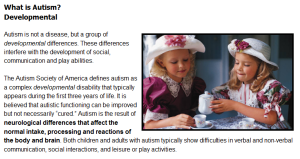 Although everyone on the autism spectrum is an individual, this course outlines a constellation of developmental differences common in autism that lead to the key concerns of social and communication issues.
Although everyone on the autism spectrum is an individual, this course outlines a constellation of developmental differences common in autism that lead to the key concerns of social and communication issues.
A person with autism experiences the world in a different way. They think and remember events differently. They react and communicate differently. By understanding the how and why of these differences, you can become one who gains insight.
Understanding some of the different issues people with autism must face can help us to be more understanding and improve our interactions. By understanding how students with autism function, we can make more informed choices in education and care and, maybe most importantly, we can assess our own automatic hard-wired responses that might occur when someone is truly different.
By understanding the underlying components of developmental differences in those on the spectrum, teachers, parents and others can reframe their own preconceived expectations and help support the learning and behavior for those with autism. Learn to more clearly understand the world from the perspective of someone with autism.
Introduction to Technology for Teachers
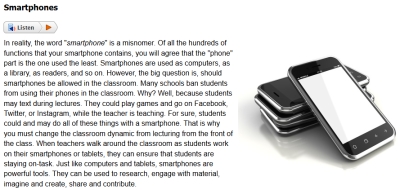 This interactive course introduces teachers to technology tools with one goal in mind: increasing teacher comfort level in using the Internet and today’s technology tools for teaching and learning. Teachers will learn new ways of using tools they are familiar with and be exposed to brand-new tools and applications for use both in professional development and with students in the classroom. Topics covered in this course:
This interactive course introduces teachers to technology tools with one goal in mind: increasing teacher comfort level in using the Internet and today’s technology tools for teaching and learning. Teachers will learn new ways of using tools they are familiar with and be exposed to brand-new tools and applications for use both in professional development and with students in the classroom. Topics covered in this course:
- Basic computer terminology
- Office applications
- Web tools
- Integrating technology in classroom lessons
- Using technology to enhance professional development
iPads in the Classroom
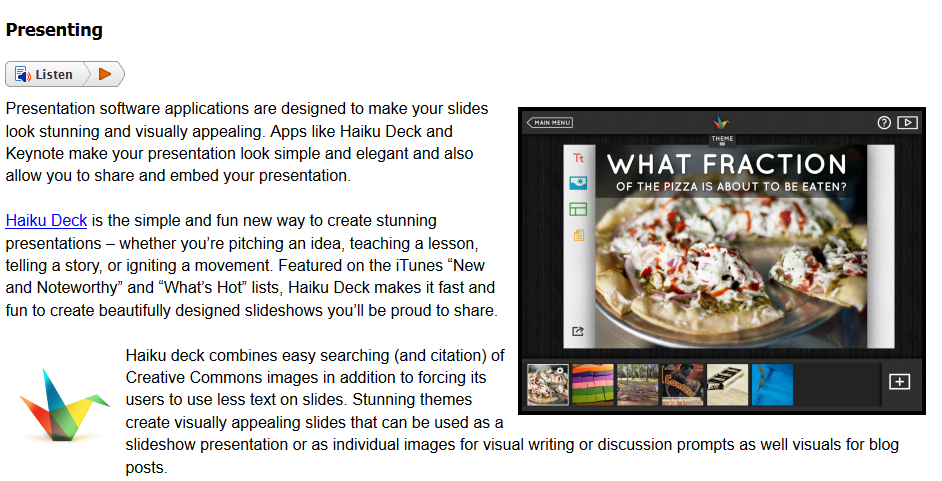 The iPad helps us prepare today’s student for today’s world in more ways than we could ever do using traditional teaching strategies. However to achieve heights in teaching and learning, teachers need to understand much more than just how to use an iPad.
The iPad helps us prepare today’s student for today’s world in more ways than we could ever do using traditional teaching strategies. However to achieve heights in teaching and learning, teachers need to understand much more than just how to use an iPad.
This course has been specially designed for teachers who are just beginning to use iPads or those who are considering using them. Rather than a focus on learning to operate an iPad, this course will help teachers gain knowledge about different ways by which the iPad can be integrated into the process of learning. In addition to practical learning activites and ideas, it helps the teacher prepare the classroom environment and schedule for the introduction of iPads. It helps teachers to plan and organize iPad use, so that it is efficient and smooth.
At the end of this course teachers will be able to:
- Learn to use an Ipad
- Find and use apps for teaching
- Organize iPad activities in the classroom
- Set up the classroom environment to encourage efficient iPad use
- Manage technical tasks related to iPad maintainace including charging, updating and storing.
- Use iPads to teach and practice 21st century skills including communicating, collaborating, connecting, creating and critical thinking.
And so much more!
Language Acquisition
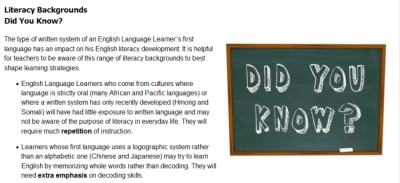 Delve into theories of the language acquisition process, and uncover practical ways for teachers to help English language learners understand lesson content. Through the strategies and information provided in this course, teachers are equipped to meet students at their specific stage of language learning and create aligned activities thus helping students achieve higher levels of linguistic fluency. The techniques presented cover the acquisition and mastery of literacy skills for students including reading, writing and dialogue, as well as understanding and supporting English Language Learners at a deeper level.
Delve into theories of the language acquisition process, and uncover practical ways for teachers to help English language learners understand lesson content. Through the strategies and information provided in this course, teachers are equipped to meet students at their specific stage of language learning and create aligned activities thus helping students achieve higher levels of linguistic fluency. The techniques presented cover the acquisition and mastery of literacy skills for students including reading, writing and dialogue, as well as understanding and supporting English Language Learners at a deeper level.
Partnering with Parents
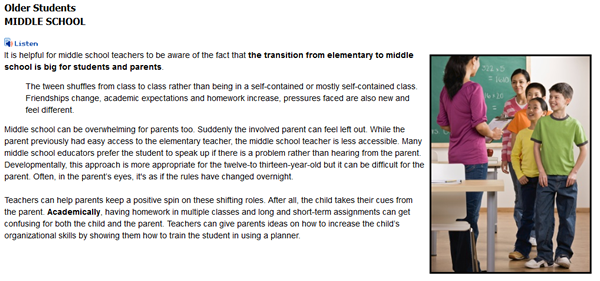 Many parents need motivation and support to help them partner with the teacher. In our profession as teachers, we must partner with the parents of our students. The “dream parents” are cooperative, freely volunteer and carry on the learning process at home. However, many parents need motivation and support to help them partner with the teacher.
Many parents need motivation and support to help them partner with the teacher. In our profession as teachers, we must partner with the parents of our students. The “dream parents” are cooperative, freely volunteer and carry on the learning process at home. However, many parents need motivation and support to help them partner with the teacher.
In this course, you will learn about various personalities and come away with an understanding of why parents think the way that they do. You will also discover strategies that you can use in a number of common challenging situations teachers face while working with parents. Finally, learn more about planning and organizing activities in your school.
This course will help you enhance your professional interaction and communication skills as well as help you build lasting relationships with the parents of your students
Project Management for Students through Project-based Learning
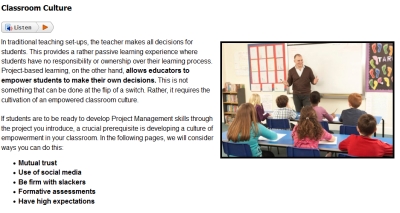 Project management encompasses a range of skills that are highly prized in the world today and include – research, collaboration, communication, leadership, problem-solving and cooperation. For the education system to truly fulfill its purpose of preparing students for a world that requires a mastery of such skills, teachers must be able to find ways to integrate project management training into their classrooms without disrupting the curricular learning. Keeping in view the challenges this poses, teachers are presented with project-based learning, as a means to successfully develop students’ needed skills, while simultaneously keeping the focus on topics within the curriculum. The integration of projects into classroom teaching is based on the finding that, often the best way students learn is by doing. Teachers are provided with a range of examples and strategies, along with an in-depth view into the effective use of projects, and understanding of how they can influence student growth at every stage.
Project management encompasses a range of skills that are highly prized in the world today and include – research, collaboration, communication, leadership, problem-solving and cooperation. For the education system to truly fulfill its purpose of preparing students for a world that requires a mastery of such skills, teachers must be able to find ways to integrate project management training into their classrooms without disrupting the curricular learning. Keeping in view the challenges this poses, teachers are presented with project-based learning, as a means to successfully develop students’ needed skills, while simultaneously keeping the focus on topics within the curriculum. The integration of projects into classroom teaching is based on the finding that, often the best way students learn is by doing. Teachers are provided with a range of examples and strategies, along with an in-depth view into the effective use of projects, and understanding of how they can influence student growth at every stage.
Public Speaking for Teachers
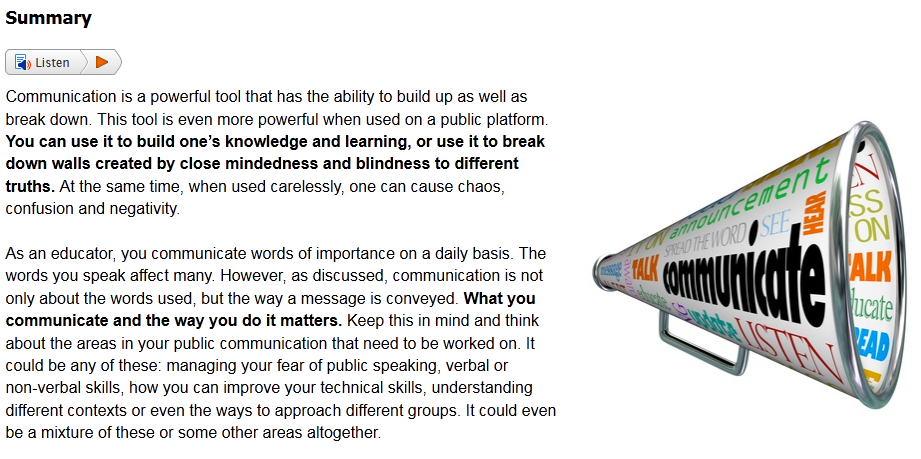 A competent and resourceful teacher must be able to effectively relate to and communicate with students, the school community, peers, parents and even school support structures such as the school board or the PTA. However, most teachers dread speaking in public speaking. Through the research and strategies in this course, teachers examine how to manage these fears and perfect related skills. Teachers are shown how they can identify and work on specific problem areas and consequently improve their communication skills, both verbal and non-verbal, as well as their technical skills. The resources included show teachers how to structure their speeches and harness technology to deliver effective speeches.
A competent and resourceful teacher must be able to effectively relate to and communicate with students, the school community, peers, parents and even school support structures such as the school board or the PTA. However, most teachers dread speaking in public speaking. Through the research and strategies in this course, teachers examine how to manage these fears and perfect related skills. Teachers are shown how they can identify and work on specific problem areas and consequently improve their communication skills, both verbal and non-verbal, as well as their technical skills. The resources included show teachers how to structure their speeches and harness technology to deliver effective speeches.
Questions answered in this course include – How do teachers really communicate in a classroom? How does a teacher prepare to speak at a board meeting? What should I keep in mind when meeting with the parents of students? This course is rich in examples, considerations, suggestions and tips for teachers to improve public speaking skills.
Reading Across the Curriculum
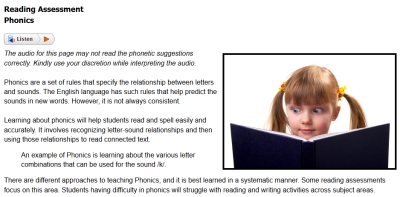 This interactive course is one option for K-12 teachers across the curriculum spectrum to demonstrate evidence of reading instruction techniques. Based on research, Reading Across the Curriculum introduces all teachers to sound reading instructional practices.
This interactive course is one option for K-12 teachers across the curriculum spectrum to demonstrate evidence of reading instruction techniques. Based on research, Reading Across the Curriculum introduces all teachers to sound reading instructional practices.
- Research
- Reading Range
- Meaningful Reading
- Strategies for Reaching All Students
- Includes Resources
- Reinforcement Activities
Reading through Technology in the Classroom
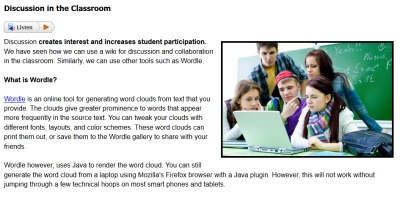 Reading is an essential skill that is central to education. In today’s classroom, students use and access information from a variety of sources, not just books. The skills of evaluating content, collaboration and peer-review become an important part of reading.
Reading is an essential skill that is central to education. In today’s classroom, students use and access information from a variety of sources, not just books. The skills of evaluating content, collaboration and peer-review become an important part of reading.
This course introduces creative strategies for reading instruction that incorporate technology. It introduces teachers to recent advances in technology and to devices and techniques which can be used to enhance reading in the classroom. The course incorporates activities, strategies, and templates teachers can use in order to enhance students’ reading skills using technology.
Recognizing Early-onset Mental Health Disorders in Children and Adolescents
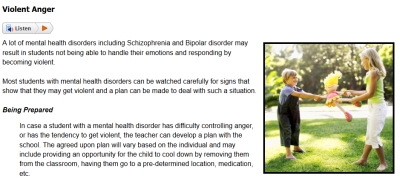 As educators and parents we are often, by default, among the first people to notice that a child may be experiencing problems. Completion of this course results in a basic understanding of warning signs of early-onset mental illness in children and adolescents which is useful to professional teaching and learning as it strengthens teacher-parent communications. Topics covered in this course:
As educators and parents we are often, by default, among the first people to notice that a child may be experiencing problems. Completion of this course results in a basic understanding of warning signs of early-onset mental illness in children and adolescents which is useful to professional teaching and learning as it strengthens teacher-parent communications. Topics covered in this course:
- What is mental illness
- Parent stages
- Communications
- What teachers can do
- Attention Deficit Hyperactive Disorder
- Oppositional Defiant Disorder
- Conduct Disorder
- Depression
- Bipolar Disorder
- Anxiety
- Schizophrenia
Have you wondered if your efforts and hard work are paying off? Have you spent time pondering over whether your teaching strategies are appropriate for your class and reviewing the results?
Developing a process of reflective thinking or reflective practice is a viable solution to this problem. Reflective practice is considered to be central to effective teacher preparation programs and the development of professional competence. A truly reflective teacher becomes sensitive and responsive to the needs, issues, and concerns that are so important in shaping qualitative educational practice. This course helps educators learn about various reflection and professional development practices that will enable you to become a reflective teacher and grow as an educational professional.
Research-based Instructional Strategies
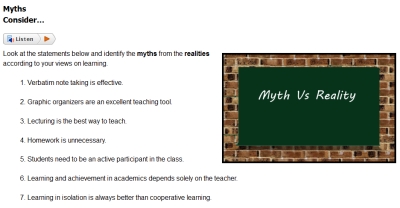 To help students improve in academic achievement, develop an attitude of learning and acquire the skills needed for the demands of the work place and real life situations, educators must continually review, reflect on and work to improve their instructional skills.
To help students improve in academic achievement, develop an attitude of learning and acquire the skills needed for the demands of the work place and real life situations, educators must continually review, reflect on and work to improve their instructional skills.
This course provides teachers with research based approaches and strategies that can be incorporated into classrooms. These will improve the effectiveness of teacher led instruction and encourage active student involvement in learning. These strategies and approaches are shown to have numerous benefits resulting in increased student achievement and learning.
Through this course, teachers can also have a look at their own views about teaching and learning, gaining a research based perspective on commonly believed myths in the educational field. Teachers are also provided with useful strategies in the areas of reading, writing and math. The course is rich in examples, templates and rubrics to help teachers understand and practically use the strategies in the classroom setting.
Standards Based Instruction through STEM
STEM integration doesn’t need a huge budget, lots of technology, or a ready-to-use curriculum. It’s something any teacher, any school and any classroom can integrate. This course teachers you how.
We understand that no one knows your students better than you. Therefore, this course is designed to equip and encourage you to integrate STEM education into your classrooms in ways that you think are most suitable for your students. You will learn how to plan your classroom set-up keeping in mind the needs of your students. You will also become confident to design your own STEM curriculum, while integrating the standards, including the Common Core Standards.
STEM education is not just about doing what’s “cool” and “in.” It is essential in today’s world that our students learn to apply what they learn in real life situations and across different subjects. The STEM model helps prepare our students for the 21st century.
Student Portfolios
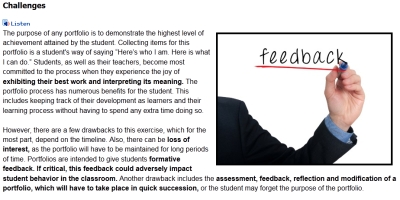 Successfully integrate portfolios to enhance students’ development and become an essential part of teaching and learning. Through the resources in this course, teachers are equipped to understand and use portfolios to emphasize the student’s role of taking responsibility for their learning and the teacher’s role of guiding that learning. The practical tips and suggestions provided in this course will take teachers through the process of implementing portfolios in their classrooms, with factual information clearly linking student learning to the actual goal.
Successfully integrate portfolios to enhance students’ development and become an essential part of teaching and learning. Through the resources in this course, teachers are equipped to understand and use portfolios to emphasize the student’s role of taking responsibility for their learning and the teacher’s role of guiding that learning. The practical tips and suggestions provided in this course will take teachers through the process of implementing portfolios in their classrooms, with factual information clearly linking student learning to the actual goal.
Teachers will be introduced to the concept of using portfolios as assessment tools, and the advantages of their implementation to both teachers and students. The resources included show teachers how to capitalize on the students natural tendency to save work, get them to take a second look and critically analyze how they can improve future work.
Questions answered in this course include – How do teachers take on the role of ‘portfolio advisors’, and guide students through the process of creating and maintain portfolios? What is the relevance of a portfolio? What are the objectives of an effective portfolio? Rich in examples, considerations, suggestions and tips for teachers, this course aims to enhance the teaching and learning experience for students.
Suicide Prevention
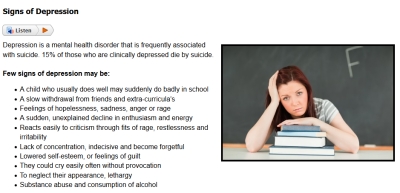 With teen suicides on the rise, suicide prevention is an important issue and teacher awareness is crucial. This course helps teachers understand suicide and how it can be prevented. Teachers will learn to identify early signs of suicide ideations and will be equipped with basic tools to help students. Teachers will be introduced creative activities and strategies that can help promote safe classroom environments. The course also equips teachers to work together with the school to initiate and implement schoolwide policies and programs on suicide prevention.
With teen suicides on the rise, suicide prevention is an important issue and teacher awareness is crucial. This course helps teachers understand suicide and how it can be prevented. Teachers will learn to identify early signs of suicide ideations and will be equipped with basic tools to help students. Teachers will be introduced creative activities and strategies that can help promote safe classroom environments. The course also equips teachers to work together with the school to initiate and implement schoolwide policies and programs on suicide prevention.
Tackling Tough Text
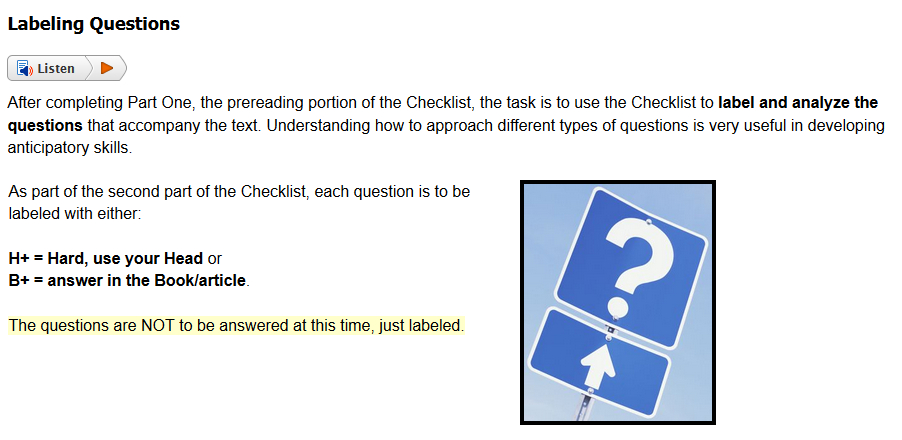 Reading and comprehension are essential skills required for academic growth and professional excellence in all fields. These skills are also vital for smooth functioning in daily life. Developing one’s students to be successful readers is an important goal for an educator.
Reading and comprehension are essential skills required for academic growth and professional excellence in all fields. These skills are also vital for smooth functioning in daily life. Developing one’s students to be successful readers is an important goal for an educator.
Sometimes, students may find certain text tough to read and comprehend. This is true especially for nonfiction texts. Students may come across vocabulary, phrases and writing styles that they find difficult to read. As students progress to higher grades, they are exposed to reading material that is of a higher level of difficulty across all subjects.
How can you help your students read and comprehend tough text, developing them into strong readers? This course deals with practical strategies on tackling tough text, with a focus on the Reading Comprehension Checklist. This checklist, to be used with nonfiction texts, integrates research-based reading strategies and is found to be successful across all subject areas.
Technology in the 21st Century Classroom
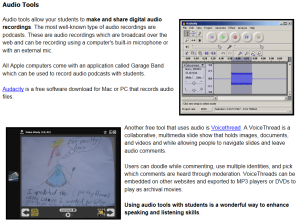 Technology has become an integral part of our life and learning patterns in the 21st century. The internet, blogs and smart phones are some examples of tools that we use to grow in our knowledge and understanding. Using technology like this in the classroom requires more than knowing how to use the tool. Teachers need to understand the role of technology in the learning process, and the principles behind integrating it in a way that it promotes learning without it being a distraction.
Technology has become an integral part of our life and learning patterns in the 21st century. The internet, blogs and smart phones are some examples of tools that we use to grow in our knowledge and understanding. Using technology like this in the classroom requires more than knowing how to use the tool. Teachers need to understand the role of technology in the learning process, and the principles behind integrating it in a way that it promotes learning without it being a distraction.
This course teaches concepts and ideas behind using technology in the classroom. It also helps teachers to understand the various skills that students need to develop in order to use technology in the most effective way. It equips teachers to help students use technology intelligently and responsibly.
Transformative Classroom Management
 What makes a teacher successful in one school is the same thing that makes a teacher successful in the next school. It is true that all students are unique and group dynamics, cultural backgrounds, and experiences vary — sometimes dramatically. But for the most part, sound ideas get positive results and unsound ideas get mixed results at best.
What makes a teacher successful in one school is the same thing that makes a teacher successful in the next school. It is true that all students are unique and group dynamics, cultural backgrounds, and experiences vary — sometimes dramatically. But for the most part, sound ideas get positive results and unsound ideas get mixed results at best.
Not all ideas sold in the marketplace of classroom management strategies lead to desirable results. In fact, many of the most popular ideas result in more harm than good. For that reason, parts of this course are devoted to explaining why many of the most popular ideas in use today are flawed, and what to do instead.
This course is a synthesis of what’s effective in the area of classroom management. It builds on extensive time, real experiences of teachers, observations of hundreds of classrooms, research and the best ideas put into successful practice.
Understanding ADHD
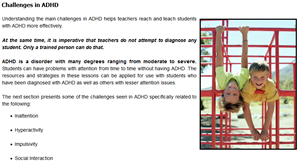 Have you ever come across a child who’s always on the move? They might have had ADHD. Attention Deficit Hyperactivity disorder or ADHD is seen commonly in today’s classroom. Children with this condition are restless, find it difficult to sit, are very impulsive and have a very short attention span. On the other hand they are also very intelligent and creative.
Have you ever come across a child who’s always on the move? They might have had ADHD. Attention Deficit Hyperactivity disorder or ADHD is seen commonly in today’s classroom. Children with this condition are restless, find it difficult to sit, are very impulsive and have a very short attention span. On the other hand they are also very intelligent and creative.
These energetic students can often disrupt a classroom. Thus, it becomes even more important for teachers to understand what this condition is all about and learn strategies to teach a child with ADHD.
This course does just that for you. It provides a variety of tips, adaptations and strategies that you can use while working in the classroom. You will learn about classroom modifications and adaptations that will help maintain order in the classroom. You will also discover methods for communicating more clearly with special educators and parents about their children. This course helps teachers gain confidence in not only handling ADHD, but also other students who are energetic, hyperactive or have difficulty paying attention.
Virtual Field Trips
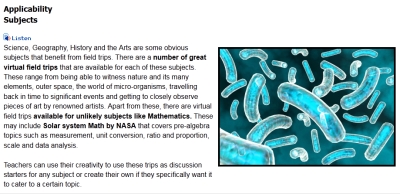 It is the wish of every committed teacher to help his or her students connect knowledge gained in the classroom with real life situations and process information in a way that takes them beyond the books. Teachers are constantly required to grab the attention of their students, keep them motivated and inspire them to own their learning.
It is the wish of every committed teacher to help his or her students connect knowledge gained in the classroom with real life situations and process information in a way that takes them beyond the books. Teachers are constantly required to grab the attention of their students, keep them motivated and inspire them to own their learning.
A well-planned field trip can serve all of these purposes in a unique way. Despite being known to be of great merit, schools across the country have been cutting short on such expeditions because of limited resources, whether financial constraints, personnel or time. This course offers a great alternative to teachers and encourages them to make the most of one of the most widely-available resources of our times – technology. Given the rapidly developing digital resources, teachers can take a diverse group of students on virtual field trips and offer them near-life-like experiences that will develop their thoughts and provide wholesome educational opportunities.
This course gives teachers a basic understanding of what virtual field trips are, the different types of trips and why they can be considered a valid alternative to actual field trips. It also offers a look at some concerns that surface while planning virtual field trips and how these can be addressed. The course also details the process of planning an effective virtual field trip with emphasis on how teachers can equip themselves technically. Looking at a selection of pre-existing virtual field trips, teachers will be able to understand the elements of a good trip. They will also learn how to create their own custom-made field trips using an array of online resources offered in the course.
Classroom examples will help teachers understand how they can incorporate these virtual trips in their lesson plans and the various roles they will play during these tours. Teachers will also be equipped to evaluate virtual field trips and will know their impact on student learning.

Reviews
No Reviews of “PACKAGE: The Everything Package (200 Hours)” yet.